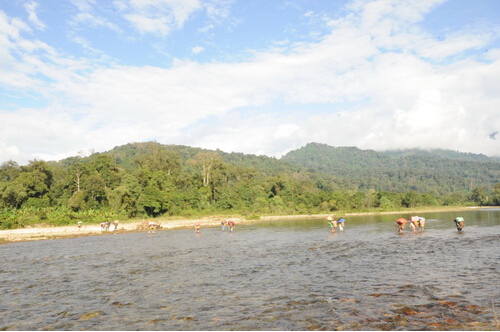The joint field expedition between Institute of Botany, Chinese Academy of Sciences (IB-CAS) and Forest Department, Myanmar was carried out in Putao District, Myanmar from 9-29 Oct.2014. Dr. Zhiduan Chen, Dr. Xiaohua Jin, Dr. Shengxiang YU and Dr. Bing Liu from IB-CAS, and Prof. SHUI Yu-Min from Kunming Botanical Institute of CAS took part in the expedition.
Myanmar is one of the countries with richest and most complex plant diversity in the world. There are ca.20 thousand higher plants. However, the investigation of plant biodiversity in the region is very limited. The Myanmar Forest Herbarium, the biggest herbarium in Myanmar, has only reserved about 20 thousand sheets specimens,
Under very severe and hard circumstances, the participants completed the field expedition efficiently and collected specimens ca. 3,500 sheets covering ca. 150 families. In addition, 2,000 DNA materials, 60 seed materials and 100 living materials were collected, and 20 thousand of colored pictures were taken. The families: Vitaceae, Begoniaceae, Balsaminaceae, Lauraceae, Orchidaceae etc.were studied especially carefully.
The joint investigation was supported by Science and Technology Foundation Project and National Natural Science Foundation of China.

The joint field expedition between Institute of Botany, Chinese Academy of Sciences (IB-CAS) and Forest Department, Myanmar was carried out in Putao District, Myanmar from 9-29 Oct.2014. Dr. Zhiduan Chen, Dr. Xiaohua Jin, Dr. Shengxiang YU and Dr. Bing Liu from IB-CAS, and Prof. SHUI Yu-Min from Kunming Botanical Institute of CAS took part in the expedition.
Myanmar is one of the countries with richest and most complex plant diversity in the world. There are ca.20 thousand higher plants. However, the investigation of plant biodiversity in the region is very limited. The Myanmar Forest Herbarium, the biggest herbarium in Myanmar, has only reserved about 20 thousand sheets specimens,
Under very severe and hard circumstances, the participants completed the field expedition efficiently and collected specimens ca. 3,500 sheets covering ca. 150 families. In addition, 2,000 DNA materials, 60 seed materials and 100 living materials were collected, and 20 thousand of colored pictures were taken. The families: Vitaceae, Begoniaceae, Balsaminaceae, Lauraceae, Orchidaceae etc.were studied especially carefully.
The joint investigation was supported by Science and Technology Foundation Project and National Natural Science Foundation of China.

